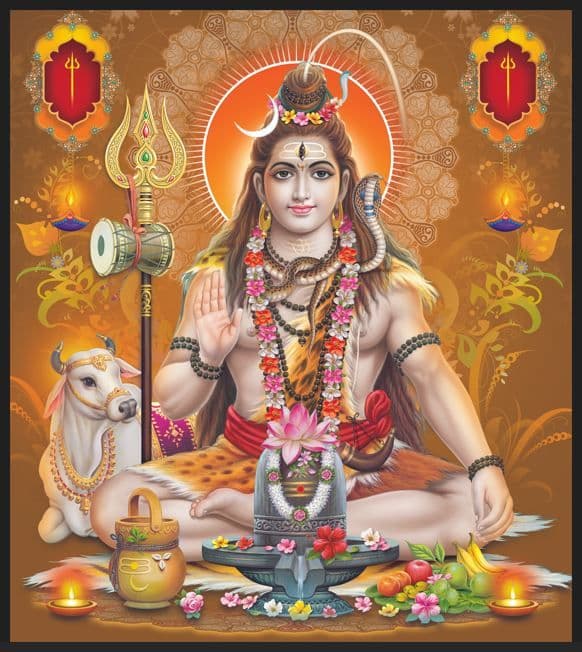Manifestations of Mahadeva
Explore the diverse and profound forms through which Lord Shiva reveals His infinite nature, from the unmanifest Supreme to active cosmic functions and iconic representations.
Supreme & Transcendental Forms
Parashiva is the highest, formless, and transcendental aspect of Lord Shiva, beyond all manifestation and attributes. In Shaiva Siddhanta and Kashmir Shaivism, Parashiva is the ultimate reality from which all creation emerges and into which it dissolves. Parashiva is Nirguna Brahman—without form, qualities, or limitations—representing the unchanging, eternal source of everything.
Explore FormSadashiva is the highest manifest form of the formless Parashiva, representing a state where the duality of subject and object begins to emerge. He is depicted with five faces and ten hands, representing the five holy acts (Panchakritya) of creation, preservation, destruction, obscuration (grace), and liberation (grace).
Explore FormPanchabrahma refers to the five faces or aspects of Shiva (Sadyojata, Vamadeva, Aghora, Tatpurusha, Ishana) which correspond to the five elements, five senses, five directions, and perform the five cosmic acts (Panchakritya).
Explore FormCosmic & Philosophical Forms

Mahadeva represents the all-powerful, compassionate, and supreme form of Shiva who pervades and governs the cosmos. Worshipped as the protector of Dharma and destroyer of evil, he is the one who holds together the cosmic law and guides souls toward liberation.
Explore Form
Ishvara is the personal form of the supreme, formless Brahman, manifesting as the cosmic controller. In Shaivism, Ishvara is Shiva who governs the universe with divine will and compassion. While Parashiva is the unmanifest absolute, Ishvara is the aspect that engages with the world — creating, sustaining, and dissolving it.
Explore Form
Shiva as the supreme teacher of yoga, music, and wisdom (Jnana), imparting knowledge silently through parā vāk (supreme speech) or non-verbal transmission. He is the Adi Guru, the first teacher, who dispels ignorance by his very presence.
Explore Form
Adiyogi is the primordial form of Shiva as the first Yogi, who introduced the science of Yoga to humanity. He is regarded as the originator of yogic systems, who transmitted profound inner sciences to the Sapta Rishis (Seven Sages). This transmission laid the foundation of all spiritual traditions rooted in yogic principles.
Explore FormIconic & Symbolic Forms

Shiva as the cosmic dancer, performing the Tandava, the dance of creation, preservation, and destruction. He dances within a circle of flames (Prabhamandala), balancing on the demon Apasmara (symbolizing ignorance).
Explore Form
A composite androgynous form of the Hindu god Shiva and his consort Parvati, representing the synthesis of masculine and feminine energies of the universe. The form is depicted as half-male and half-female, split vertically, symbolizing the inseparable nature of Purusha (consciousness) and Prakriti (nature).
Explore Form
The fierce and terrifying manifestation of Shiva associated with annihilation, destruction of ego, and protection. Often depicted with fearsome attributes like multiple arms, sharp teeth, a garland of skulls, and accompanied by a dog.
Explore Form
A radical ascetic sect of Shaivism known for their extreme practices. They seek liberation by embracing what society considers taboo or impure, seeing divinity in everything.
Explore Form
Neelakantha is the form Shiva assumed after consuming the deadly Halahala poison that emerged during the Samudra Manthan (Churning of the Ocean). To save the cosmos from destruction, Shiva drank the poison, which lodged in his throat and turned it blue, giving him the name 'Neelakantha'. This act is seen as the ultimate self-sacrifice for cosmic welfare.
Explore Form
An abstract or aniconic representation of Shiva, often depicted as a cylindrical pillar, sometimes emerging from a yoni (representing Shakti). It symbolizes the formless (Nirguna) yet potent (Saguna) nature of the Absolute Reality.
Explore Form
Tripurantaka is the form of Shiva who destroyed the three cities (Tripura) of the demons Tarakaksha, Kamalaksha, and Vidyunmali. These cities symbolized ego, ignorance, and attachment. The annihilation signifies the destruction of the triple impurities (Mala, Karma, Maya) that obscure the soul. Shiva destroyed the cities with a single arrow, riding a chariot made by the gods themselves, symbolizing the convergence of all cosmic forces under his supreme will.
Explore Form
Mrityunjaya is the victorious form of Shiva who conquers death (Mrityu) and grants freedom from mortal limitations. He is invoked through the powerful Maha Mrityunjaya Mantra for healing, protection from untimely death, and spiritual awakening. As Mrityunjaya, Shiva transcends time and mortality, guiding the devotee beyond fear and into immortality and peace.
Explore Form
Pashupati is one of the most ancient and foundational aspects of Shiva, worshipped as the supreme lord of all creatures (Pashu). In this form, Shiva is the compassionate master who governs and ultimately liberates all living beings from the bonds (Pasha) of ego, desire, and ignorance. Pashupati represents the soul's journey from bondage to ultimate freedom and spiritual realization.
Explore Form
Chandrashekhara is the peaceful and majestic aspect of Lord Shiva who adorns the crescent moon (Chandra) on his jata (matted locks). This form symbolizes Shiva's dominion over the mind, emotions, and the ever-flowing cycles of time, which the moon governs in Hindu cosmology. The moon on Shiva’s head represents the waxing and waning of the mind and the stability one can achieve through spiritual mastery.
Explore Form
Vishwanatha, meaning 'Lord of the Universe', is a majestic and all-encompassing form of Lord Shiva. Revered as the eternal guardian of Kashi (Varanasi), Vishwanatha is considered the supreme consciousness that governs all creation. He is believed to bestow liberation (moksha) upon those who depart the world in Kashi, whispering the sacred Taraka Mantra in their ears at the moment of death. This form symbolizes absolute authority over space, time, life, and death.
Explore Form